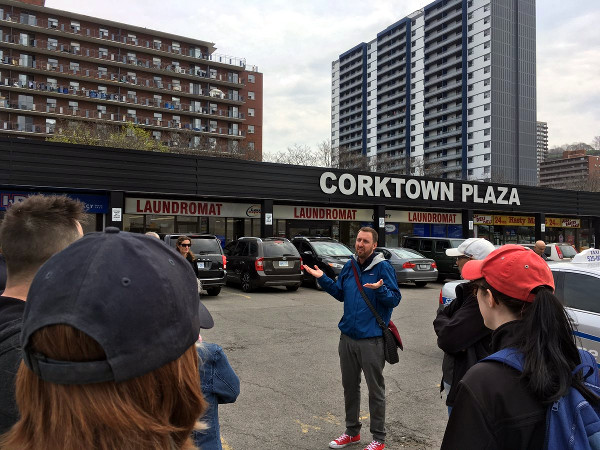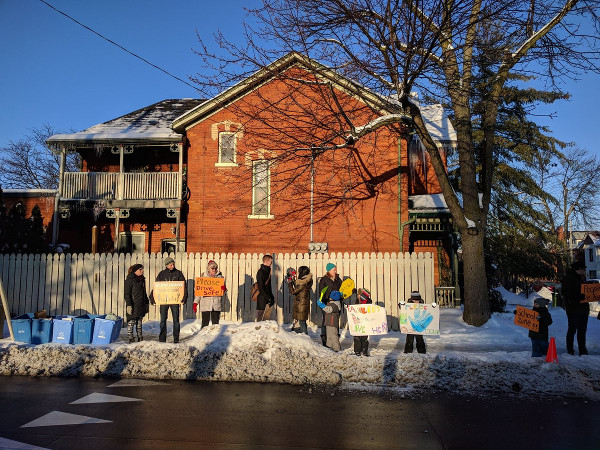We cannot continue to keep treating engagement as an exercise that happens once or only around one issue and then stops abruptly.
By Cameron Kroetsch
Published June 12, 2018
Community engagement has been at the heart of the work I've been doing for a while now. For me, engaging with my community has been a joyful learning experience that continues to prove how welcoming and accepting Hamiltonians are. It's been my experience that when you genuinely ask someone for their input, they genuinely want to tell you their story.
I've also learned that it's not hard to get Hamiltonians to tell their stories. When Hamiltonians get together, we talk about Hamilton. We care deeply about our communities, our neighbours, and our City.
And we want our City to mirror that affection.
At the moment, too much of the engagement that we're part of as residents is through "straw polls" or one-time PIC (Public Information Centres) meetings and not through genuine dialogue.
We can do better, Hamilton, but only if we demand it of ourselves.
Too often, engagement only comes about as the result of a legal requirement. I can't tell you the number of times I've been forced to listen to carefully-woven sentences detailing the minimum requirements under the law. Of course, the minimum requirements under the law are just that. We can exceed those minimums and do more than just what's required.
Even when the City engages as the result of a requirement, such as when new developments are moving forward, this often means only notifying a small group of property owners.
In almost every case, that notification comes in the form of a complicated, wordy, intimidating legal document that few can interpret or understand and which almost always has a fast-approaching deadline. Few people have the time, access, or knowledge required to respond in a manner that could possibly get the City's attention.
And let's not forget, this only applies to property owners. Tenants are not legally entitled to be notified.
Some critics of this argument have suggested that large signs are posted in our neighbourhoods to let us know about proposed developments and that anyone who walks by is able to find out what's happening.
Sadly, when you examine these signs you find out that they really aren't very useful. Like the notices that are mailed out, the signs are written in an unclear language that's not accessible.
Even worse, the signs no longer contain the meeting date, even though they used to. That's right: the signs are literally posted to announce a meeting and don't include the date of that meeting.
If we can't schedule a date for a meeting before a sign goes up, then we're not serious as a City about making sure people can attend a meeting. Residents need to schedule time off work, since the meetings are set for 9:30 AM, and that's not something most employers are willing to accommodate at the last minute.

Cameron Kroetsch leading Jane's Walk on the future of Corktown, May 6, 2018
A completely different example of this kind of lopsided engagement can be seen in the situation surrounding the Queen and Herkimer intersection on the border of Wards 1 and 2.
To put it mildly, there have been a lot of collisions and near-misses at and around this intersection. I stood out in the cold this past winter with a bunch of other people in an effort organized by Tom Flood, a parent and activist who lives in the area, to bring awareness to the speed at which cars travel down this stretch of road.

Safe streets protest at Queen and Herkimer, February 12, 2018 (RTH file photo)
While that demonstration was effective in getting people to slow down, it was the culmination of an incredible amount of frustration, activism, and volunteering. Rather than implementing sweeping changes to redesign the intersection immediately to protect the people who use the area, the city continued to institute incremental changes, some temporary, in an attempt to mitigate the problem.
Residents went to sleep one night, months later, and woke up the next to a series of bright plastic bollards in the intersection. It was quickly obvious that they were installed in the wrong place (in the bike lane, in one instance) or that they literally weren't able to stand up to the speeding traffic.
An easier path to engaging residents would have been to check in with the community to see if this solution addressed their concern, not to assume that it did.
What I've tried to describe is what I see as the often reactive and non-collaborative approach to civic engagement.
It isn't a secret to anyone that there are dangerous intersections and streets all around the downtown. But rather than lead with a purpose and vision, our City expects us to volunteer our time to do all of the heavy lifting and problem solving.
When a solution finally does emerge after an exhausting public campaign, it's not communicated to the people who fought for it but quietly installed in the dead of night to avoid any possibility of collaboration.
This isn't to say that engagement only happens this way but I think it's important to provide some concrete examples of the types of things I hear from residents every day. They're all tired of the silent treatment.
Despite this, there is a motivated and vocal group of residents who do attend City meetings, write in to the City, and organize their neighbours.
While individuals engage on their own, It's often a neighbourhood association (NA) that does this work - and on a volunteer basis, I might add. These volunteers go around knocking on doors in their neighbourhoods, gathering up documents from City Hall, scrambling to organize meetings, and generally doing their best to represent their neighbours. But it's really not their job to do this work.
Considering the vast amount of change happening in Hamilton that calls for community engagement, it's not possible for NAs to stay on top of everything.
The City has come to rely on these volunteers to pick up the slack, to fill in where the City underfunds its engagement strategy, and to speak for entire neighbourhoods. NA meetings have become the de facto go-to place for City politicians to do "straw polls" so that they can go back to a City committee or even City Council to declare support or opposition.
The truth is, and anyone involved in an NA will tell you this, that NAs don't represent entire neighbourhoods and they don't have the resources that the City of Hamilton has - a city that has the 10th largest population in the country.
There are some simple things we can do to start to fix this problem, today:
Stop asking City staff to write reports about engagement. They've been written and staff knows what needs to be done. Empower them do it. Employ City staff, full-time and not on contract, to coordinate community engagement. Far too often we're asking precariously-employed City staff to help precarious neighbourhoods. It's a model that makes absolutely no sense. If we're serious about community engagement, we need to empower the people at the City who are doing this work - no excuses.
Have our councillors address the bigger political questions. I've been at far too many meetings where someone asks an elected official a question, only for them to turn to staff for an answer so that they can hide under cover. Let's be bold about our thoughts and let's act like leaders.
Write all announcements in easy and accessible clear language. There are courses offered by the Adult Basic Education Association (ABEA) in Hamilton on clear writing - let's get our communications staff trained to write in ways that encourage more access.
Put dates on signs that announce meetings. This is really easy. Just commit to a date and make it happen and don't put the sign up until you've got that figured out.
Stop pushing solutions on to tomorrow. Some things are clear and easy. When they are, we need to act.
Provide information to meeting participants in advance. The wait-until-the-event-for-the-reveal effect wore off a long time ago, really. If we want genuine participation we have to stop holding on to all of the cards. Give up the cards, let people have access to the information, and let them say whatever they want to say.
Bring City-paid minute-takers to all community meetings. We all tire of being asked to "write down our comments" in order for them to be taken seriously. The presumption that everyone can write them down is a bit galling. Accessibility is real.
Treat all residents equally and stop distinguishing between tenants and property owners. If it's too hard to notify people who live in apartment buildings or who rent property in Hamilton then solve that problem already (call me if you need ideas).
All of these little things will help, but not unless we start to understand the iterative power of engagement. We cannot continue to keep treating engagement as an exercise that happens once or only around one issue and then stops abruptly.
Engagement is a dialogue. It's about planning the next opportunity to talk to residents, figuring out new ways to engage people, and leading boldly to make this happen.
Are we already doing this sometimes? Yep. We definitely are. There are brave and passionate City staff breaking the mold regularly. You know who you are.
To our City politicians, let's stop being so afraid of our shadows. We can insist on meaningful dialogue without putting our ambitions for reelection ahead of what's right for the health of our neighbourhoods.
I don't think I'm going to show up on a horse with my white cisgender privilege to save anyone's day. I do think, though, that we can work together with the community to come up with a better model.
There are lots of great groups in Hamilton (and some outside of Hamilton) who could help us with this and who we could listen to more often. Here are just a few that I've been lucky to get to know:
The Centre for Community Engaged Narrative Arts at McMaster University
The Community Engaged Scholarship Institute and the International Institute for Critical Studies in Improvisation at the University of Guelph
The Office of Community Engagement at McMaster University
The Good Shepherd Hamilton's Core Collaborative Learning program
If the City needs help or suggestions about how to engage, they should reach out to the amazing professionals who do this work on a regular basis.
Residents want to be part of decision-making and they want to be kept up to date about what's going on in their neighbourhoods.
While I don't think we have an easy path ahead as civic leaders, it has to start by taking a serious look at why and how we engage residents and who continues to benefit from that engagement.
Editor's Note: Cameron Kroetsch is a registered candidate for Ward 2 in the upcoming October 22, 2018 municipal election. You can see the official list of registered candidates on the City of Hamilton's Nominated Candidates for Mayor and Ward Councillor web page.
Raise the Hammer has a longstanding policy of not endorsing candidates, and this article should not be regarded as an editorial endorsement of the author. However, all candidates are welcome to submit articles for publication. We will accept any submission that does not violate our submission guidelines. Raise the Hammer is a free, volunteer-run publication that does not charge money for access to content and does not receive any revenue of any kind, including for commercial or political advertising.
You can find all of our municipal election coverage on our elections website.
You must be logged in to comment.
There are no upcoming events right now.
Why not post one?